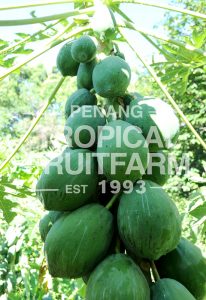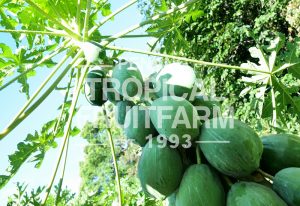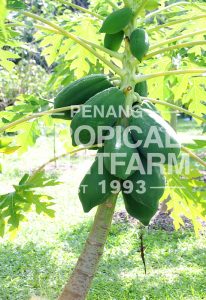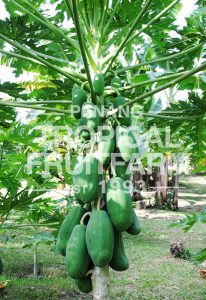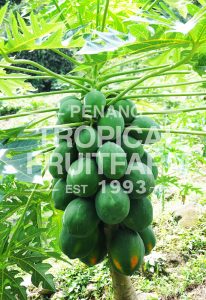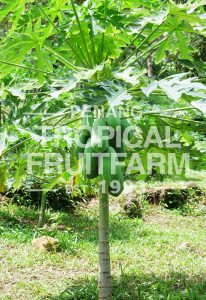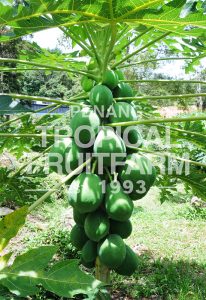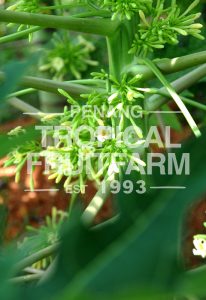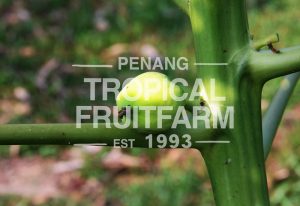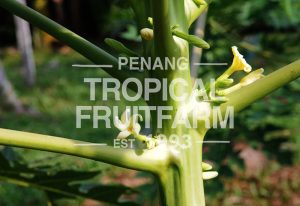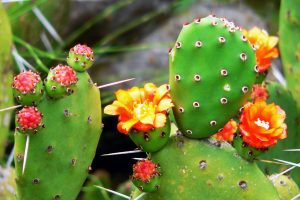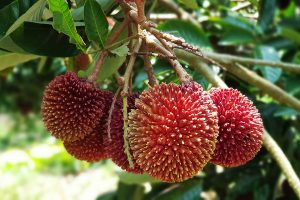| Origin | Native to tropical America, from Southern Mexico and neighbouring Central America. Grown worldwide in tropical and subtropical areas. |
| Description | Papaya is a tall plant, without branches. It is a herbaceous plant because the stem does not have much wood and remains soft and green until its death. The fruit is melon like with sweet juicy flesh. |
| Growth Habitat | Papaya grows best in warm areas below 50 ft (152m) elevation. Fruit production and quality decline at higher elevations. Papaya can tolerate moderate winds if well rooted. 40 to 60 in (102-152 cm) of rainfall evenly distributed throughout the year is adequate for growth. |
| Foliage | The leaves emerge directly from the upper part of the stem in a spiral on nearly horizontal petioles 1 to 3½ feet long. The blade, deeply divided into 5 to 9 main segments, varies from 1 to 2 feet in width, and has prominent yellowish ribs and veins. The leaves are large, 50-70 cm (20-28 in). The life of a leaf is 4 to 6 months. |
| Flowers | The five-petalled flowers are fleshy, waxy and slightly fragrant. They appear on the axils of the leaves, maturing into large fruit, 15-45 cm (5.9-18 in) long and 10-30 cm (3.9-12 in) in diameter. Prior to opening, bisexual flowers are tubular and female flowers are pear shaped. |
| Fruits | Generally, the fruit is oval to nearly round and, in some cases, like a big pear., First, the skin is green but it changes to yellow in ripe fruits. In a ripe fruit, the pulp is yellow, orange, pink and even light red. Inside the fruit, there are many small black seeds. |
| Harvest | Papayas are ready to harvest when most of the skin is yellow-green. After several days of ripening at room temperature, they will be almost fully yellow and slightly soft to the touch. When papaya plants are short, fruits can be harvested by hand while one is standing on the ground. Fruit should be cut from plant to reduce damage |
| Soil | Papaya grows well on many types of soil, but they must be adequately drained. The soil needs to be moist in hot weather and dry in cold weather. While doing best in light, porous soils rich in organic matter, the plant will grow in scarified limestone or various other soils if it is given adequate care. |
| Pruning | Papayas do not need to be pruned, but some growers pinch the seedlings or cut back established plants to encourage multiple trunks. |
| Fertilization | In commercial plantings, fertilizers are either broadcast onto the soil surface within the leaf drip zone or applied through drip irrigation lines. Organic matter mixed with the soil before planting and applied afterward to the soil surface as much helps to ensure good rooting conditions and a supply of micronutrients. |
| Propagation | Papaya is grown from seeds and is sown either in containers or directly in the ground. Papaya plants can also be grown from cuttings, which should be hardened off for a few days and then propped up with the tip touching moist, fertile soil until roots form. |
| Nutritional Properties | Papaya has more carotene compared to other fruits such as apples and guavas. Carotene in food is converted into Vitamin A in our body. This fruit is considered as one of the richest source of Vitamin C, even surpassing the citrus fruit orange. This fruit is also rich in Vitamin A, E, B and antioxidants like carotene, zeaxanthin and flavonoids. Even several important minerals like potassium, magnesium, calcium and iron are found in papaya. Apart from these, it contains the proteolytic enzymes, papain and chymopapain, which can break down proteins to amino acids. |
| Health Benefits | Papaya, when consumed regularly, will ensure a good supply of Vitamin A and C. Being a good source of beta carotene, regular doses of papaya as a fruit can also prevent some forms of cancer. Papain, the most popular enzyme, is exclusively present on in the papaya; an excellent aid to digestion. It can prove beneficial for cardiovascular system as well, since it is a good source of Vitamin A, C, and E, all of which are powerful antioxidants, which can prevent the oxidation of cholesterol. It also has anti-inflammatory properties, for which can be effective for relieving inflammation. This medicinal property can be attributed to the enzymes and antioxidants present in papaya. Even individuals with inflammatory conditions like, osteoarthritis and rheumatoid arthritis can benefit from it, due to its high vitamin C and E content. |
| Commercial Uses | Papaya is widely used for tenderizing meat. Unripe fruits and leaves are consumed as vegetables. The black seeds of the papaya are edible and are sometimes ground and used as a substitute for black pepper. Papaya seeds are also used as an ingredient in salad dressing. Papain is a milky latex collected by making incisions on unripe papayas and the latex is either sun-dried or oven-dried and sold in powdered form to be used in beer clarifiers, meat tenderizers, digestion aids, wound debridement aids, tooth-cleaning powders, and other products. In some parts of the world, papaya leaves are made into tea as a treatment for malaria. |
| Food Suggestion | Papaya can be juiced, after taking the skin and seeds, this juice can be mixed with milk to make smoothies. Serving Tips: -nRipe papaya fruit is usually eaten raw with a twist of lemon drops. - Fresh papaya cubes are a great addition to fruit salads. - Papaya juice with ice cubes is a popular drink. - Its cubes are used in ice creams, shakes, sorbets, salsa, etc. - Ripe fruit also goes well with chicken and seafood savory dishes. Unripe green papayas can be used as vegetable, either cooked, usually in stews, stir-fry, curries, and soups. |









